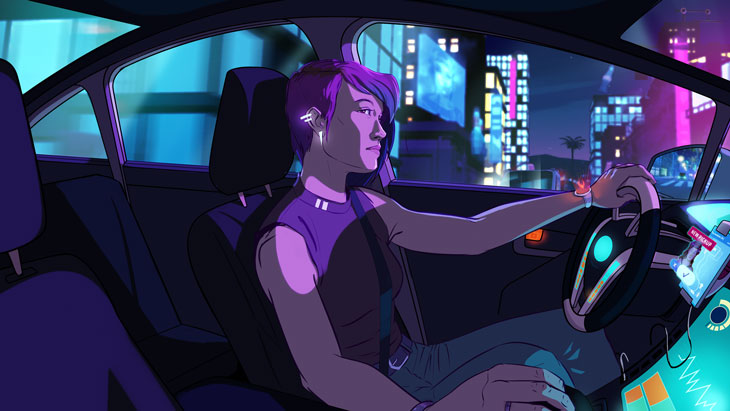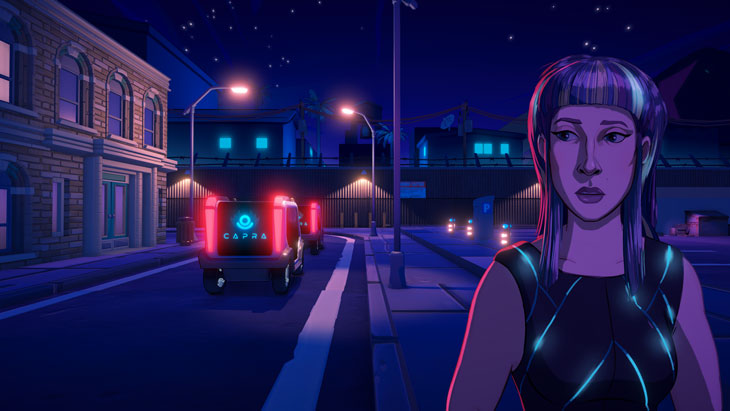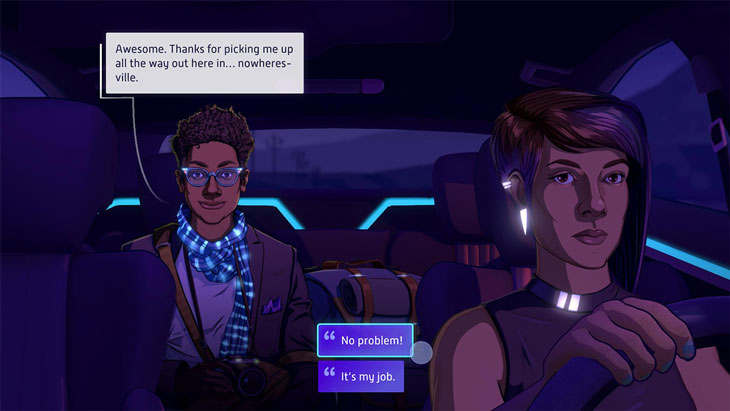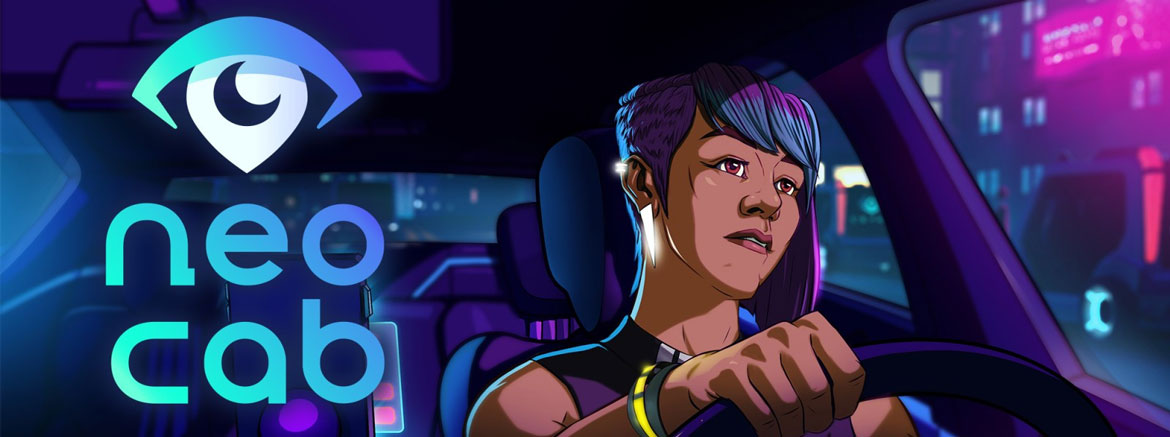FULL DISCLOSURE: THE GAME USED FOR THIS REVIEW WAS SUPPLIED BY FELLOW TRAVELER

Neo Cab, a visual novel from the new studio Chance Agency, has been on my radar for a while. First hearing about it a while back in some E3 coverage, it was a game about the last human cab driver in a world of self-driving cars. I didn’t hear a whole lot about it from day to day, but it was always in the back of my mind. Something about the way the developers talked about the relationship between a cab driver and their passenger just stuck with me. Now that I’ve played the game, though, I don’t think it’s going to be sticking with me much longer.
Set in Los Ojos, a near future city where a massive tech company called Capra owns basically everything, from self-driving cars to the police to the currency you use, you step into the driver’s seat of Lina, a driver for Neo Cab, and one of the only remaining human cab drivers in the city. Leaving your home town and coming to Los Ojos to move in with a childhood friend who you had a massive fight with not too long ago, things go awry when your friend goes missing. While the mystery of what happened to her is the driving force of the narrative, the real story is all about your passengers. With a story broken up over the course of multiple days, you go from passenger to passenger, talking to them and trying to maintain your star rating. During the rides, you get to learn more about the city, more about Lina’s past with her friend, Savy, and more about the passengers themselves. With repeat passengers, you can build something of a relationship with them, as they open up to you about themselves and their problems.

The main obstacle between you developing that relationship is yourself. Or, more accurately, your emotions. One of the first things you’re given in the game is some wearable tech called a FeelGrid, a bracelet that displays a color and level readout representing your emotional state. Things passengers say and things you say may swing your emotions to one extreme or another, and in doing so, can change the dialogue options you have available. Sometimes what you’re feeling can stop you from saying certain things, and other times you can get completely new options. At the start of the game, this sounded really interesting. Having to manage your emotions while trying to work information out of passengers that might know what happened to Savy, it would have been really interesting to see how that would work. Unfortunately, it doesn’t ever really work that way before the very end. From passenger to passenger, as well as day to day, the emotions that you’re feeling can swing wildly from one side of the spectrum to another, with not much rhyme or reason. The game doesn’t offer much indication which dialogue options would push you in which direction, so the mechanic becomes something of a guessing game.
As for the working information out of passengers, maybe it was just the people I chose, but I got one, maybe two, passengers that actually had information about my missing friend that I had to extract from them. The game can’t effectively progress without you reaching certain points, so instead of letting things come about more naturally, more often than not, a passenger will just tell you something important. Sometimes, it’s not even passengers. Lina has a journal that she writes things in occasionally, and at one point a piece of information that tells you the answer to a question Lina just asked is already in there. Some of the dialogue will refer to things that Lina hadn’t learned yet, presumably because it was information she’d gotten from passengers I’d never given rides to. None of this game play actually felt like it was bringing me closer to the ending of a mystery. It all felt like I was waiting for a countdown to expire before I was told the ending.
Once you get to that ending, though, it’s incredibly disappointing. The game has multiple endings, so it may have just been the one I got, but it involves a confrontation that brings the FeelGrid back into play in a big way. When you get the FeelGrid, the instruction booklet for it says that it’s better to keep your emotional state at a particularly low level. Getting too deep into any part of the emotional spectrum can be bad. As I approached the end, Lina started going deep into the anger spectrum and just kept pushing it until, eventually, she just crashed straight into depression, which pissed real me off even more because I was still angry. I then had to slog through the last 10 minutes or so, unable to actually respond to anything because Lina was too depressed. The FeelGrid had, up until this point, barely played into my game at all until this point, but once it did I was stuck on the path and could do nothing about it.

Ending not withstanding, there is some decent character writing in Neo Cab. All of your passengers, for better or worse, are fairly unique characters, each with their own personalities and ambitions. There were a few characters who I got attached to, and would jump at the chance to drive them around again should they need a ride. And learning about this new world through them was well done, too, even if some of the ideas were a bit too out there for what had been established. There are two things, specifically, that feel a strange in this game. The first is a mech suit made for children. Overprotective parents lock their kids in one of these things and it keeps them safe inside its virtually indestructible shell. But the kids can’t take it off until they’re 18, and the parents can just override motor control and move their kids around as they see fit. The second is a radical underground movement that wants to see all cars outlawed, both the self-driving and the human driven ones. The group, and a few other people sprinkled throughout the city, call cars “death machines,” and the movement wishes to go back to simpler time when people just walked or rode their bikes. Long distance travel and transport be damned, cars are the enemy of the people. For whatever reason, the latter idea makes the least sense to me.
The choice they made for character animations doesn’t feel natural to me, either. Being a visual novel, there’s not a whole of movement out of the character models. But what movement there is, it’s done in a motion comic style, where to the 2D drawings of the characters are digitally manipulated to move and emote and such. The drawings look fine, but when they begin moving around it looks really awkward. There’s also not a whole lot of room for nuance in expressions. When the passenger or Lina is on the extreme side of happy or angry or sad, that’s one thing, but anything in between gets muddled and hard to read. The city itself looks fine. Very dark grey buildings with highlights of bright, fluorescent neon. It provides a light neo-noir feel to everything outside the car, but, no matter where you drive, nothing really changes or at least feels like it changes. As a result, the entire city feels the same even if the dialogue is describing various districts differently.
Neo Cab never really succeeds at pulling you into the story it’s trying to tell. Whether it’s the bizarre look of the characters, the samey feeling of the entire city, or the story just telling itself with no input from you, there’s always something pulling you out of the experience. This is a shame, given the uniqueness of the core ideas it has.
Score: 2.5/5
Mediocre




Add comment